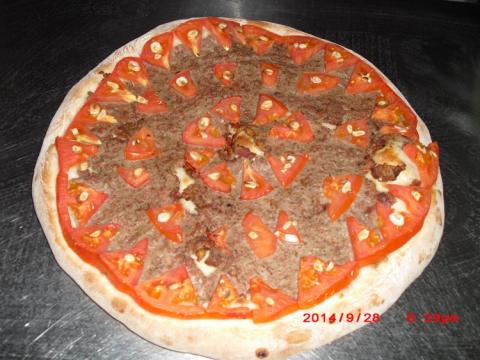
Yay, finally learned how to make great pizza crust!
One of the reasons I started learning how to make bread was that one of my favorite foods was pizza, and I was never quite happy with my crust, I felt that crusts I got at good pizza places were usually better. My pizza making efforts started in the 1980s. In 2011 I gave up eating cheese, should have never had it due to milk allergy, and I took my last picture of my last cheese pizza (not sure where that photo is) at the same time.
The other day I happened upon a video, New York Pizza Crust by Bruno Di Fabio.
He uses an advanced straight dough process with a long cold fermentation. It wasn't clear to me what temperature he used, but I got the impression it was warmer than 36-38 °F, the temperature of my home refrigerator.
| Pizza dough by Bruno di Fabio | Straight Dough Process | ||||
| lbs, oz, vol. | lbs | % | g | ||
| High Gluten Flour | 50 lbs | 50 | 100.00% | 600.00 | |
| water | 12 qt | 24.99 | 49.98% | 299.88 | |
| olive oil | 24 oz | 1.5 | 3.00% | 18.00 | |
| eggs | 6 lrg | 0.66 | 1.32% | 7.94 | |
| sugar | 10 oz | 0.625 | 1.25% | 7.50 | |
| salt | 10 oz | 0.625 | 1.25% | 7.50 | IDY |
| fresh yeast | 2 oz | 0.125 | 0.25% | 1.50 | 0.0825% |
| 157.05% | |||||
So, after doing some conversions (in which I could have made errors), I made two no-cheese pizzas, or whatever they might legally be called, over the last couple of days, one was his crust formula and process, though the water amount was far too stiff. I wanted my pizza sooner than the long cold ferment, so increased the yeast a little and baked it that evening with a roughly 6 hour rise, and just like most of my straight dough experiments, the result was a pale crust color that didn't want to brown. But when eating this, OMG, the crumb had reasonably large holes and the bottom was crisp!
http://www.onegreenplanet.org/plant-based-recipes/caramelized-vegan-onion-tart-with-olives/
The next day I changed the process to sponge and dough, and got better colors on the crust. The crumb holes were every bit as nice.
Meat and potato pie.
It seems I need a docker to deal with the oven bubbling. In reviewing this, it is interesting to note that crust bubbling was not an issue with the straight dough, only the sponge dough. I use a big tile, and preheat a home gas oven to 550°F, as hot as it will get. Opening the door to put the pizza in drops it to 475°F, and during the bake of the next 14 minutes or so, it remains at 475, the gas burner on the whole time, so opening the door to pop a bubble just isn't in the realm of possibility. I have fantasized about adding electric elements to the oven for additional heating power, though I won't do it for liability reasons, nor can I afford one of the upscale ovens, I'm lucky and grateful to have the one I used.




Comments
Nice to see the results. I came across this same video today and was interested in it, especially because of the eggs. Nice to see your home adaptation.
From previous experience I highly recommend sticking to the 24-36 hours in the fridge as instructed in the video. This is really key to both extensibility and flavor, and I use that technique in all of my recipes. After making a lot of pies, the fridge time is one thing I never take a shortcut on, it does really make a big difference. In fact, at least one pizza chain design their pizza skins the same way: just a tiny bit of yeast, with long fridge ferment, enables them to transport the dough from central distribution centers over several days without issues. This helps them maintain quality across geographically distant locations.
I've got a gas home oven too, and was surprised that it took 14 minutes to bake your pizza with your oven set to 550F. I use a 1/4" thick pizza steel in my oven, which helps tremendously. I preheat to 550F about 1 hour, and get a good char in 5 minutes on the steel, and finish the pie under the broiler for about 2 minutes.
The egg amount is low, but the bottom crust is wonderfully crisp, which had prior been elusive. I understand that mono- and diglycerides are basically egg replacements, I'm guessing they are safer for companies to use than eggs, to which some folks are probably allergic.
I've wondered about trying steel instead. I don't have an oven thermometer, it's one of those items that I plan to get someday, so the reported temperatures are just from the dial setting. The oven I use doesn't have a broiler, it is bottom heat only. It's possible I should lower the pie closer to the heat source, currently I use the middle of the oven, approximately.
I've made this one more time, since this writeup, and used a second large tile above it, and was able to keep the temperature at 500°F after opening the door and placing it. I do plan to try the long, cold fermentation, soon.
With the sponge and dough formula, it's possible I put a little bit of dead yeast in it to create extensibility. At this point, I don't remember.
Thanks for your tips, cranbo!